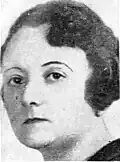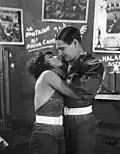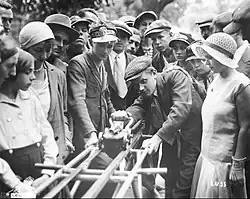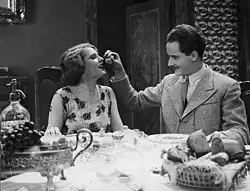Leo-Film
| Industry | Film production |
|---|---|
| Founded | 1920s |
| Headquarters | Warsaw, Poland |
Key people | Maria Hirszbein, Bolesław Land |
Leo-Film was a film production company based in Warsaw, Poland,[1][2] operating in the 1920s and 1930s. It was one of the most significant film studios among approximately 150 active in the Second Polish Republic during the interwar period.[3][4]
History
The origins of the studio are linked to the activities of Leon Forbert and Maria Hirszbein, who was employed by him from 1924. Forbert's studio specialized in producing feature and documentary films in Yiddish. Over time, Hirszbein became a co-owner, and in 1926, after buying out Forbert's shares, she became the sole owner.[5] She then renamed the studio Leo-Film,[6][7] previously known as Leo Forbert, Forbert-Film, and Efes-Film.[8] In 1932, after entering into a partnership with set designer and architect Bolesław Land, Hirszbein lost decisive control over the company's management. A few years later, following Land's death in 1936, she regained control.[5][9][10] Leo-Film was one of the most prominent film studios in Poland during the 1930s.[1][2]
The main directors of Leo-Film's productions were Henryk Szaro and Juliusz Gardan, who began their artistic careers at the studio.[9] The studio also collaborated with Michał Waszyński, Marta Flantz, Aleksander Ford, Zygmunt Turkow, and Bazyli Sikiewicz. The latter made his directorial debut with Tajemnica panny Brinx. Additionally, Leo-Film launched the acting careers of Franciszek Brodniewicz, Tadeusz Fijewski, Helena Grossówna, Tola Mankiewiczówna, and Nora Ney.[9]
In 1932, a major success for the studio was the film drama Legion ulicy, directed by Aleksander Ford.[11] The story of Warsaw's newspaper vendors was named the best film of the year and is still considered a masterpiece of interwar Polish cinema. The film was innovative, as it was the first in Polish cinema to portray marginalized young people forced into early independence and adulthood. It received widespread acclaim from both critics and audiences, winning a readers' poll organized by the pre-war weekly Kino.[11] No fragments of the film have survived to the 21st century.[9][12]
Gallery
-
 Maria Hirszbein, long-time owner of Leo-Film and one of the first women in Polish film production
Maria Hirszbein, long-time owner of Leo-Film and one of the first women in Polish film production -
 Eugeniusz Bodo and Nora Ney in a scene from Czerwony błazen, the first feature film produced by Leo-Film
Eugeniusz Bodo and Nora Ney in a scene from Czerwony błazen, the first feature film produced by Leo-Film -
 Still from Legion ulicy, recognized as the best film of 1932 in Poland
Still from Legion ulicy, recognized as the best film of 1932 in Poland -
 Hanna Rozwadowska as Jadwiga Barczyńska and Zbigniew Sawan as Henryk Barczyński in a scene from Serce na ulicy
Hanna Rozwadowska as Jadwiga Barczyńska and Zbigniew Sawan as Henryk Barczyński in a scene from Serce na ulicy -
 Scene from Zew morza (1927), featuring Stefan Szwarc (standing, with pipe) as Rudolf Minke, Henryk Rzętkowski (in striped shirt) as Smuggler, and Michał Halicz (right, leaning) as Gang member
Scene from Zew morza (1927), featuring Stefan Szwarc (standing, with pipe) as Rudolf Minke, Henryk Rzętkowski (in striped shirt) as Smuggler, and Michał Halicz (right, leaning) as Gang member
Films produced
- 1925 – Nowa Palestyna i otwarcie Uniwersytetu W Jerozolimie (documentary)
- 1926 – Czerwony błazen
- 1927 – Zew morza
- 1928 – Kropka nad i
- 1929 – Policmajster Tagiejew
- 1930 – Uroda życia
- 1931 – Serce na ulicy
- 1932 – Legion ulicy
- 1933 – 10% dla mnie
- 1933 – Prokurator Alicja Horn
- 1933 - Ulica[15]
- 1935 – Kochaj tylko mnie
- 1936 – Tajemnica panny Brinx
- 1936 – Papa się żeni
- 1937 – Ślubowanie
- 1939 – Kłamstwo Krystyny
References
- ^ a b Haltof, Marek (2015). "Film Studios". Historical Dictionary of Polish Cinema. Rowman & Littlefield. p. 72. ISBN 9781442244719.
- ^ a b Haltof, Marek (2019). "The Sound Period of the 1930s. Adaptations, Patriotic Melodramas, and Films in Yiddish". Polish Cinema: A History (2nd ed.). Berghahn Books. p. 71. ISBN 9781785339721.
- ^ Majewska, Barbara (2017). "Analiza interesariuszy polskiego rynku filmowego" [Analysis of Stakeholders in the Polish Film Market] (PDF). Zeszyty Naukowe Politechniki Częstochowskiej. Zarządzanie (in Polish). 25 (1): 140–155.
- ^ "Polish Cinema of the Silent Film Era". Culture PL. 13 August 2012. Retrieved 8 July 2025.
- ^ a b "Maria Hirszbein – przegląd Filmoteki Narodowej" [Maria Hirszbein – National Film Archive Review]. Ownetic.com (in Polish). 16 August 2018. Retrieved 6 July 2025.
- ^ a b Żebrowski, Rafał. "Hirszbein (Hirszbejn) Maria". Żydowski Instytut Historyczny (in Polish). Archived from the original on 26 September 2020.
- ^ "Przegląd produkcji filmowych Marii Hirszbein – w sierpniu na festiwalu "Warszawa Singera"" [Review of Maria Hirszbein's Film Productions – August at the "Warszawa Singera" Festival]. Dzieje.pl (in Polish). 13 August 2018. Retrieved 6 July 2025.
- ^ "Towar eksportowy przed 1939 rokiem" [Export Commodity Before 1939]. Rzeczpospolita (in Polish). 10 November 2008. Retrieved 6 July 2025.
- ^ a b c d "Warszawa Singera. Maria Hirszbein – producentka filmowa" [Warszawa Singera. Maria Hirszbein – Film Producer]. Filmoteka Narodowa (in Polish). 21 August 2018. Retrieved 6 July 2025.
- ^ Kowalczyk, Piotr (6 August 2018). "Maria Hirszbein. FINA na Festiwalu Warszawa Singera" [Maria Hirszbein. FINA at the Warszawa Singera Festival]. Filmoteka Narodowa (in Polish). Retrieved 6 July 2025.
- ^ a b Grzechowiak, Jarosław. "Przed intronizacją. Twórczość Aleksandra Forda w latach 30" [Before Enthronement. Aleksander Ford's Work in the 1930s]. Edukacja Filmowa (in Polish). Retrieved 6 July 2025.
- ^ "Producentka Filmowa – Maria Hirszbein" [Film Producer – Maria Hirszbein]. Stowarzyszenie Filmowców Polskich (in Polish). Retrieved 6 July 2025.
- ^ "Leo-Film. Filmografia" [Leo-Film. Filmography]. FilmPolski.pl (in Polish). Retrieved 6 July 2025.
- ^ "Leo-Film". Reunion 69 (in Polish). 25 March 2014. Retrieved 6 July 2025.
- ^ "Polish Newsboys". The New York Times. 27 January 1933. Retrieved 8 July 2025.